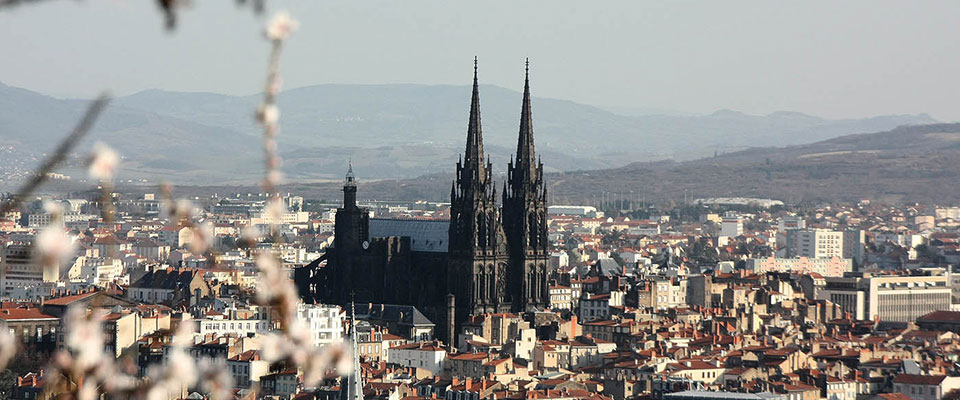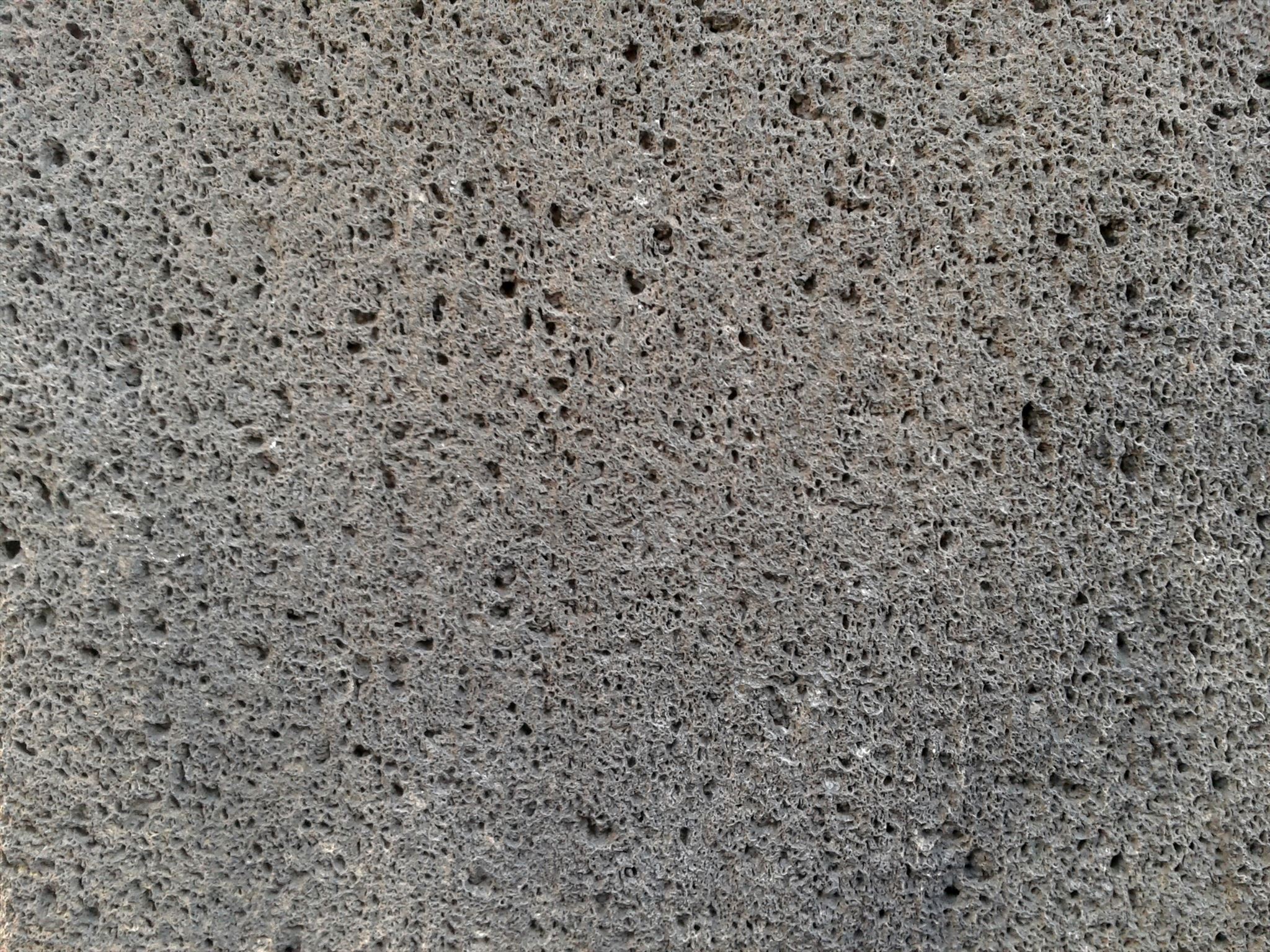FRANCAIS
La cathédrale Nore Dame de l'Assomption de Clermont-Ferrand se trouve au sommet de la butte centrale qui forme le centre ancien de Clermont-Ferrand.
Les plans initiaux sont l’œuvre de Jean Deschamps.
L’originalité géologique de l’édifice est le matériau de construction utilisé : La pierre de Volvic.

Nombreux sont les touristes qui pensent que la robe grise de la cathédrale est due à la pollution industrielle de la ville voire aux rejets de particules noirs de gomme des pneumatiques de la manufacture Michelin.
La pierre de Volvic est une trachy-andésite. Elle provient des coulées du volcan du Puy de la Nugère. Ce volcan a connu une volcanologie il y a 11 000 ans. Il a notamment vécu un épisode de type strombolien effusif qui a donné naissance à des coulées trachy-andésite d'où elle est extraite.
C'est une pierre de couleur grise avec de nombreuses petites bulles et du feldspath. Elle résiste au gel, aux produits chimiques. Elle présente un faible coefficient de dilatation. Toutes ces caractéristiques en font un matériau intéressant pour la construction.

C'est la construction d'églises à la fin du XIIe siècle et au XIIIe siècle dans la région clermontoise qui marque le début de son utilisation intensive dans les villes de Basse-Auvergne : Riom, Clermont-Ferrand etc. Elle fut par la suite très utilisée dans ces villes. Sa couleur sombre donnant un aspect très typique à l'architecture des quartiers historiques des villes de cette région. Parmi les réalisations, on peut voir à Clermont-Ferrand, la maison Savaron ou la fontaine d'Amboise.
Sa texture et sa dureté en font également un matériau se prêtant bien à la sculpture. Elle est utilisée pour de nombreux monuments funéraires. Elle est à ce titre toujours utilisée pour la sculpture. On peut voir par exemple de nombreuses sculptures utilisant ce matériau à Chapdes-Beaufort sur le Chemin Fais'Art.
Ses qualités vis-à-vis de la température, son haut point de fusion (environ 1 500 °C) font qu'elle est utilisée, sous l'appellation de lave de Volvic, comme substrat pour l'émaillage de la pierre, qui demande un chauffage à une température moyenne de 960 °C. Le comte de Chabrol-Volvic en fut l'initiateur ; en tant que préfet de la Seine de 1812 à 1815, il l'utilisa pour les plaques de rue à Paris. Cette utilisation fut pérennisée quelques années plus tard par un arrêté du préfet Rambuteau, en 1844.
La lave de Volvic fut également utilisée par la société Michelin pour ses plaques signalétiques de routes et d'agglomérations.
Même si les quantités ont diminué, elle est toujours utilisée à des fins artistiques ou pour les tables d'orientation.
Actuellement seule une entreprise exploite encore la pierre de Volvic, l’entreprise Mallet est la seule survivante. Elle emploie sept carriers et 12 scieurs de pierre pour exploiter les trois dernières carrières de pierre de Volvic. La quantité extraite chaque année est de 800 m3 .
Pour valider cette earth cache vous devrez répondre aux questions suivantes :
- De quel volcan est issue la pierre de Volvic utilisée dans la construction de la cathédrale de Clermont ?
- Au niveau du transept côté place de la victoire, aux coordonnées de la cache vous trouverez un panneau expliquant la construction de l’édifice, citer l’autre roche souvent utilisé dans la construction des édifices religieux auvergnats. Lister les 3 édifices mentionnés sur ce panneau et leur style architecturale
- Approchez vous de la façade de la cathédrale, vous distinguerez les bulles d'air dans la roche, Quelle diamètre moyen caractérise ces bulles ?
Loguez cette cache "Found it" et envoyez-moi vos propositions de réponses soit via mon profil, soit via la messagerie geocaching.com (Message Center), et je vous contacterai en cas de problème.
ENGLISH
This earth cache will allow you to understand the particular color of Clermont's cathedral.
She is at the top of the central mound which forms the former center of Clermont-Ferrand.
The initial plans are Jean Deschamps's work.
The geologic originality of the building is the used material of construction: the stone of Volvic.

There are many tourists who think that the black dress of the cathedral is due to the industrial pollution of the city even in the black rejections of rubber particles of the tyres of the factory Michelin.
The stone of Volvic is a trachy-andésite. She results from castings of the volcano of the Volcanic hill of Nugère. This volcano knew a vulcanology 11 000 years ago. He lived in particular an episode of strombolian type effusif which gave birth to castings trachy-andésite where from she is extracted.
It is a stone of grey color with numerous small bubbles and with the feldspar. She resists the frost, the chemicals. She presents a low coefficient of expansion. All these characteristics make a material interesting for the construction.

The characteristics of the stone of Volvic make a very good material of construction for buildings(ships). It is the construction of churches at the end of the XIIth century and in the XIIIth century in the clermontoise region that marks the beginning of its intensive use in the cities of bass-Auvergne: Riom, Clermont-Ferrand etc. She(it) was afterward very used in these cities. His(her,its) color sinks giving a very typical aspect to the architecture of the historic districts of the cities of this region. Among the realizations, we can see in Clermont-Ferrand, the house Savaron or the fountain of Amboise.
Its texture and its hardness also make a material lending itself well to the sculpture. She(it) is used for numerous funerary monuments. She(it) is used as such always for the sculpture. We can see for example numerous sculptures using this material to Chapdes-Beaufort on the Path(Way) Fais' Art.
Its qualities towards the temperature, its high melting point (approximately 1 500 °C) make that she(it) is used, under the naming of lava of Volvic, as substratum for the enamelling of the stone, which asks for a heating an average temperature of 960 °C. The count of Chabrol-Volvic was the initiator; as prefect of the Seine from 1812 till 1815, he(it) used him(it) for street plates in Paris. This use was perpetuated a few years later by an order of the prefect Rambuteau
The lava of Volvic was also used by the company Michelin for its descriptive plates(patches) of roads and urban areas(conglomerations).
Even if the quantities decreased, she(it) is always used in artistic purposes or for viewpoint indicators.
At present only a company still exploits(runs) the stone of Volvic, the Mallet company is the only survivor. She(it) employs seven quarrymen and 12 stony sawyers to exploit(run) the last three stony careers(quarries) of Volvic. The quantity extracted every year is 800 m3.
To validate this earth hides you will have to answer the following questions:
1. From what volcano arises the stone of Volvic used in the construction of Clermont's cathedral?
2. At the level of the transept side places of the victory, in the address and phone number(coordinates) of the hiding place you will find a panel(sign) being understandable the construction of the building, to quote the other rock often used in the construction of the religious buildings from Auvergne. List 3 buildings mentioned on this panel(sign) and their style architectural
3. Approach you of the facade of the cathedral, you will distinguish air bubbles in the rock, What average diameter characterizes these bubbles?
Loguez this hiding place " Found it " and send me your proposals of answers either via my profile, or via the geocaching.com messaging (Center message), and I shall contact you in case of problem.
